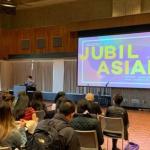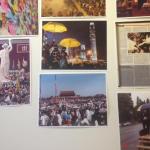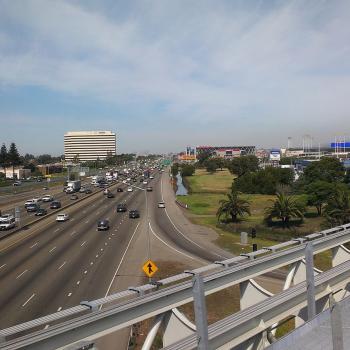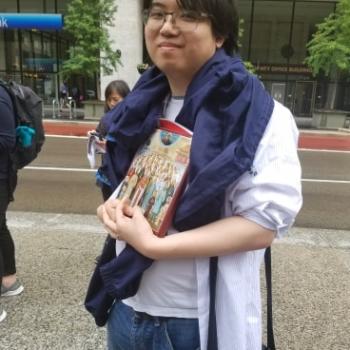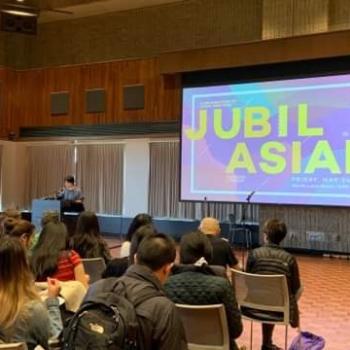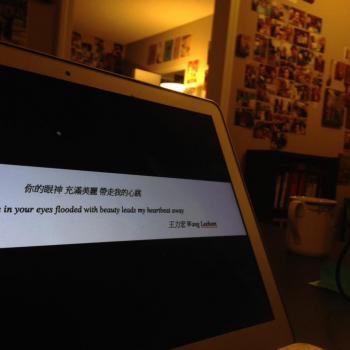
I think it was midway into my senior year in high school that my family decided that we were moving to Canada. That was while we were in the Bay Area. That’s the San Francisco Bay Area, for the uninitiated, and this is your last warning, as I won’t repeat the long form version of what the region is called. I went to school in Hayward. We lived in Fremont. Both are places that folks who are not from Northern California ever really hear about.
I had gotten the idea about Canada around my sophomore year two years before. As I watched the Twin Towers collapse and another plane ram through the Pentagon on 9/11, it immediately dawned on me that if there was a time when Americans would go to war, it would be about then. Those were times when folks talked openly of conscription, especially in the lead-up to a war in Iraq that I found very strange while watching the news media, as I was not really sure what the connection between Saddam Hussein and Al-Qaeda was. I remember telling my friend, who later became an air force pilot, that it was a little crazy, that despite my conservative tendencies, and in spite of the climate of what palpably felt like a national emergency, I felt like I was becoming anti-war. He said, But I’m still pro-war. I thought I was going crazy, that the world was becoming topsy turvy.
From those thoughts was born the idea for me to go to my father’s graduate school alma mater, the University of British Columbia. There, as an underemployed engineer the 1980s, he had worked through a qualifying year for advanced education in civil engineering because he had basically majored in beer as an undergraduate. He tells many stories about the number of engineering pranks to which he bore witness. One time, I am told, the engineers took a cow to the top of the clock tower; unable to bring it back down whole, they did it piece by piece. Having expended all the credits in that discipline, he came away with a master’s degree in mining instead. Vancouver was where I had been born, though I am told that Vegas is how I was conceived.
With the political chaos in the United States in the early 2000s, I decided to head to the Lower Mainland for school myself. It turns out it was a good deal: citizenship meant that I paid local tuition. My father, a diabetic for whose health insurance the church he pastored was not paying, said that he and the family were coming too, and there was nothing I could do to stop him from depriving me of my college independence.
One night, around the time we were leaving Fremont, I was in the car, window rolled down, when my dad asked me how I felt. I replied melodramatically: There’s nothing for me here anymore. I told my pop psychoanalysis posse person Eugenia Geisel this story a few months ago. OMG, she replied, I know why you love Lady Bird. You ARE Lady Bird!
The truth is that I was worse than Lady Bird. That character, as well as her author and director Greta Gerwig, were from Sacramento. At least that was the capital of California. When I tried to explain where I was from outside of the Bay Area, I’d have to say that I was from San Francisco. I was not, of course. I thought the neighbourhood where my relatives used to live was called the ‘Ocean District’ because I was not sure what the Sunset was, to which a friend of mine who knew the City, as we called it, very well kindly muttered, I didn’t know there was an Ocean District. The truer truth was proclaimed every few minutes by the classical music radio station I’d listened to growing up: You’re listening to Classical 102.1 KDFC, San Francisco, Oakland, San Jose, and worldwide on kdfc.com. I think KDFC isn’t on the 102.1 FM frequency anymore, but the metropolitan principle still holds: the Bay Area has three cities, and the reason I didn’t know the City was because I was sandwiched in my everyday life between Oakland and San Jose, neither of which I knew very well either. I suppose I was a tad more acquainted with them than, say, Los Angeles, which everyone in Vancouver thought I was from and asked if I lived next to a movie star in Cali because, of course, ‘San Fran’ (which no one in the Bay Area calls it) is right next to LA in the popular imagination outside of California. I could thus fool the uninitiated. But that just made visiting my hometown harder: I was experiencing numerous levels of alienation from it.
The truth of the matter is that conceiving of Fremont as a suburb of all these other big cities in the Bay Area is the problem. The whole point of Fremont, which is an incorporation of what used to be Washington Township into the unified school districts of Alviso, Centerville, Niles, Irvington, Mission San Jose, and Warm Springs, was that property owners didn’t have to go to Oakland anymore to get their issues heard by a municipal government. The other purpose, of course, was to make sure that Hayward, which had also incorporated in the north, wouldn’t encroach on their lands, and the infighting over how to deal with that northern hegemon caused a split with the cities of Newark and the towns of Alvarado and Decoto, which separately incorporated as the not-so-subtly named Union City. You might say that San Jose subsequently became the big power in the area, with the development of Silicon Valley; indeed, the planning scholar Willow Lung-Amam sets up her account of how Asian Americans came to settle Fremont with the emergence of the scientific knowledge using silicon as a conductor that came from scholarship at Stanford University and the subsequent tech boom in Santa Clara County, which is where San Jose is, and which is of course the real other half of the Francisco dynamic duo, with the city by the Bay up in the peninsula named for St Francis of Assisi and the area down south christened for St Claire of Assisi. Indeed, many of the original inventions leading to the Silicon Valley becoming what it was took place in Fremont, including the making of the first Apple computer.
I grew up in this Fremont-Hayward corridor, along the route 880 that was unveiled as the Nimitz Freeway in 1957. When my dad took a job in Sunol, he decided to settle us in Fremont, while driving every day through Niles Canyon where Charlie Chaplin had made some of his earlier films. We eventually lived in a district called Ardenwood, where if the streets were not named after Shakespeare characters (for a time, we lived on Lodovico Court), they were English writers like Milton. Being from the city of ditches called Richmond, British Columbia, where settlements in an area below sea level were enabled by a ditch system to drain out water, my parents were fascinated by what our family called the ‘levee,’ the trail along a long ditch that went through Fremont and eventually led from Quarry Lake to a wildlife preserve called Coyote Hills. In the old town of Centerville where there was an old creamery, a historic theater, and various older establishments that could have been the façade of a scene of small town America, they found a place that did the perfect Shanghai food — hot soy milk done both sweet and savoury, stir-fried rice cakes, Chinese donuts, steamed and fried dough dumplings filled with pork goodness. They also got into what they came to see as ‘American food’ through the four Greek American diners on various sides of Fremont: the Country Way, where they had many a lunch date over pastrami sandwiches and all-day breakfasts of French toast; Dino’s, where I learned what a ground round was; Baldie’s, where I had my first souvlaki; and Dina’s, where I discovered that omelettes are even better when they are filled with feta cheese.
Liberal optimists will overplay their hand and call what they see here a multicultural paradise. In fact, there is a whole documentary that has been made about Fremont precisely in these terms by a research team from Harvard — Fremont, U.S.A. — that sees its religiously pluralistic landscape as an integral part of its Pluralism Project. I still remember how I heard about it. I was in Richmond, long after having moved there, when I was on the exercise bike in my family home and listening to the Gifford Lectures in 2009, a series I had been told by my friends and colleagues to pay some attention to because of its insistence on ‘natural religion,’ how questions of religiosity relate to the immanent domains of natural and social sciences. I later learned that some of the greatest works in religion had started out as Gifford Lectures, like William James’s Varieties of Religious Experience and Charles Taylor’s Secular Age. I was listening to Eck’s lectures on pluralism, having never read her book A New Religious America, when I heard her start talking about Fremont. My bike riding slowed; at one point, I got off the bike because I had to hear what she was saying clearly. I could understand Richmond, my new site of relocation (and also where I was born), in the terms of religious pluralism; my colleagues Claire Dwyer and David Ley were starting a research project, with me as the boots-on-the-ground researcher, on what the locals called the ‘Highway to Heaven,’ a stretch of three kilometers on No. 5 Road where agricultural land had been transformed into over twenty religious institutions. But what Eck was saying was that I never had to move to Richmond to find that landscape; it had always been in Fremont, albeit scattered across the city instead of concentrated into one assembly line.
If Eck was to be believed, then one could argue that Fremont could be a case study for the podcast Asian Americana, which advertises itself as a series ‘about slices of distinctly Asian American culture and history.’ I’m not sure about that designation, and neither is Lung-Amam, I think, because Asian Americans — by which I do not mean only ‘East Asians’ but also South and Southeast Asians and Arab Americans — had to fight to be included in Fremont. The typical Asian American fights over the school district lines being redrawn to make Mission San Jose High School less concentrated by Asians are well-documented, but it was Eck herself who has written extensively about the case of Alia Ansari, a Muslim woman who was killed by a white supremacist in 2006, two years after I had left. Indeed, in the wake of 9/11, it was discovered that Fremont had the highest concentration of Afghanis in the entire country, a fact further popularized by the works of Khaled Hosseini beginning with his bestseller, The Kite Runner. Eck might have painted a rosy picture of interreligious and pluralistic cooperation, but underlying it, Lung-Amam argues in a contribution to a rich literature on racial formations in the suburbs in whose number we must also include Wendy Cheng’s Changs Next Door to the Diazes, are the racially charged questions of whether Asian Americans, which includes all persons who have been gazed upon by the leering stare of orientalizing fantasy, fit into this American landscape. It’s a question I was asking as I left Fremont, of whether the bubble tea shops and the anime and manga vibe that seemed to be making the all-American ‘suburb’ of Fremont new, were fundamentally changing its character.
There was, in other words, a kind of shame about being from Fremont, and it didn’t have to do with the typical questions in Asian American representation about smelly lunches and perceptions of asexuality, though those affected me deeply too, especially during the process of puberty. Describing Fremont literally as ‘Asian Americana’ — not just Asians creating our own representational culture in the landscape, but also being attentive to how that place is a post-industrial one that emerges from small-town agricultural and industrial America — might sound charming to those who are not from there, but for me as an angsty adolescent, it didn’t prevent me from accessing more mainstream narratives of liberal assimilation and then realizing that this city was literally preventing me from becoming white. I spent the last few days that I lived in Fremont stewing over the changes I was alleging to have been taking over the city, the seeming replacement of old-time Americana with a manga ethos. I came back from my last hang-out with a dear friend upset by this, and my mother and sister, troubled at what I was becoming, asked me what was wrong. I wondered out loud to them what had happened, then spent the next day at a Starbucks journaling. I should probably find those entries now. They would reveal that I was becoming a white supremacist and that the truest irony had been completely lost on me: I was moving from there to Richmond, arguably the most Asian suburb on this continent.
I look back over my career since leaving Fremont and reflect that I have spent much of it working out this phantom limb, of my whole family having left the place so that the place where I grew up and was racially formed was then amputated from my life. I ended up in the social sciences, with their century-long vogue in studying structures of assimilation with the assumption that that’s what people who move to America want to do and that is Asian American studies is simply about the study of Asian migrants embracing the American Dream and what Will Herberg terms its ‘Way of Life.’ I worked in Chinese churches, convinced that my role was to make my peers more confrontational and direct, less of the emo anime cosplayers who constantly looked sleepy and had bad hair. The longest running thing was my free association between American popular culture and Catholicism. I had a friend in elementary school, an Irish Catholic kid, whose house was a library of all the great American classics, from Laurel and Hardy to the Three Stooges. I had never heard of such things, and I was fascinated by his weird Americana, down to the haunted houses and playful penchant to mess with witchcraft through Zelda and Magic: The Gathering. Eventually, I too became Catholic and now have a pop psychoanalysis sensibility.
The thing that one learns from trying to be white, though, is that at a certain point, you just don’t fit in, even if the people are nice. It’s especially true if one is on the job market, when one learns that being treated with politeness does not mean that one will get hired. I should have known this point earlier, though. After moving to Richmond, I was very taken by the college movies of my generation that featured the figure of the ‘manic pixie dream girl‘: Scarlett Johansson in Lost in Translation, Natalie Portman in Garden State, Kirsten Dunst in Elizabethtown. My dad watched the last one with me and was immediately inspired to take me on a beer tour through the south, to the heartland of Americana. What I did not realize was that my dad was also trying to teach me about race on that road trip too. In St Louis, we were served by a black waiter who stood around our table and made more jokes with us than any other of the guests in the restaurant, and in the hotel room later, Dad remarked that what had happened there was that we people of color were sticking together. At the Grand Ole Opry in Nashville, the white usher told us to go upstairs, and Dad was mad: it was a blatant act of segregation, and he knew it, though I did not. In his own way, Dad attempted to convey to me that as much as he and I both loved America and Americana, this is a fundamentally racist society. If I did not see color because I thought I had assimilated, then I did not see my own oppression. He was so proud of me when years later, he got me dirt drunk, and I stumbled around his house screaming about how I had been orientalized on the job market. Finally, he thought to himself, and so did those around me that I told.
The last few years have been a referendum on my assimilationist tendencies, which just so happened to coincide with my being hired in Asian American studies and my conversion to Eastern Catholicism. One dark night when I had become convinced that I’d be unemployed for the rest of my life, I realized my error. Asian Americana does not refer, I reflected, to an either-or between assimilation or the takeover of American culture by the Asian popular cultures that I disdained. It is much more like what was happening in Fremont, that the structures of the city, which had excluded Asians from the outset, were being consumed and put to use by Asian Americans. It was us Asian and Latinx kids, regardless of whether we were Christian or not, who filled the seats of the classrooms of the Assemblies of God school I attended. It was the Shanghainese restaurant in the middle of old town Fremont. It was the bubble tea shops in the suburban plazas. It was Asian Americans and other people of color taking what is classically known as Americana and using it on our own terms, the practice of everyday life, as Michel de Certeau SJ puts it, in which we take the given landscape and use it for whatever the hell we want.
When I finally visited Fremont with my wife, we went to Pho 99. To me, this Vietnamese establishment was simply the simple eatery across the street from where I lived as a teenager. I later learned that people came on pilgrimages to the intersection of Paseo Padre Parkway and Fremont Boulevard for this place’s broth. For me, though, the plaza was simply home, not only to this pho restaurant but also another, as well as a Shanghainese restaurant, a Cantonese bakery, and the large Asian supermarket Ranch 99 Market, which had significantly shortened my mother’s commute to the other supermarkets, one in Union City, the other in Newark. I still remember how my wife, whom I had met in Richmond and who was here on her first trip to the Bay Area, tasted the soup, with the reverence she gives every bowl. Her eyes lit up. She could not believe that I had grown up with it and taken it for granted. Neither could I.
I now have a better understanding of why I appreciate Americana now; it is because I grew up, with apologies to the podcast, surrounded by Asian Americana. Fremont was where I simply took for granted that Asian Americans simply consume the landscape and, as Lung-Amam puts it, make our place in it. I am no longer protective of the whiteness into which I tried to assimilate; as a reflection of my growth that surprised me much later even as I said it, I am on record saying that if there is any integration that has to happen in ethnoburbs, it should be as Asian America. Even as I have worked my way through this blog, I found ways of pinning my intellectual mistakes on my time in Fremont, but just as Lady Bird rediscovers the beauty of driving through Sacramento by the end of the film, I am no longer ashamed of being from Fremont. It is where I grew up, and thus also the roots of my journey of the intellect, with my geographical questions about assimilation, secularity, and orientalism. To my hometown, I am now grateful.
I write these thoughts at the intersection of three events: the end of Asian Pacific Islander Desi American (APIDA) month, the conclusion of Mental Health Awareness Month, and my name day, which is June 1. Holy Justin the Philosopher and Martyr, pray to G-d for us.

